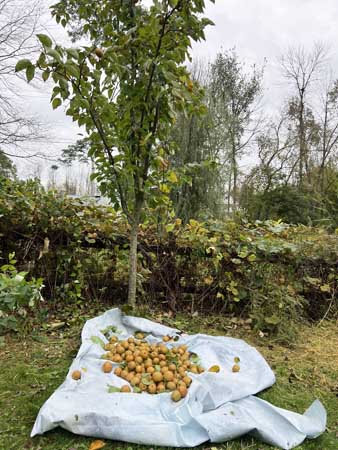 I love my Asian Pear trees. I have two different varieties, both of which are prolific without spraying. One ripens by mid-September, and this tree ripens mid to late October.
I love my Asian Pear trees. I have two different varieties, both of which are prolific without spraying. One ripens by mid-September, and this tree ripens mid to late October.
The first time I tasted these, I was surprised by the satisfying crunch followed by a rush of sweetness and juice. They taste like a cross between a sweet pear and a hint of concord grapes!
As part of my food forest, these pears provide food to snack on fresh off the tree and food to get us through the winter.
I have lots of Asian Pear recipes, but I’ve already baked enough to fill a small freezer. That’s why this bunch will get dehydrated.
But there’s so much more to these pears than their refreshing taste. From their rich history to their nutritional benefits and unique cultivation, Asian pears hold a special place in the hearts and diets of many.
History and Origin: The Journey from East to West
The story of Asian pears, also known as “nashi” in Japan, “bái lí” in China, and “bae” in Korea, takes root in the foothills of China, the presumed birthplace of these fruits. Historians believe that their cultivation began approximately 3000 years ago, spreading to Japan and Korea around the 8th century. Unlike their Western counterparts, Asian pears have always been revered for their crisp, apple-like texture, a trait that has remained dominant through centuries of cultivation and consumption.
These pears made the leap from Asia to the Western world in the 1800s, with immigrants bringing seeds and saplings into the United States. Today, they’re grown in regions like California, Oregon, and Washington, offering a juicy bite of the East in the Western landscape. But they grow well in almost any temperate climate. I live in the Northeast and they thrive here.
Varieties and Characteristics: More than Just a Pear
The sheer variety of Asian pears is remarkable. They come in different shapes, sizes, and colors, ranging from round and apple-like to more traditionally pear-shaped fruits, with green, yellow, or even brown skins. Some popular varieties include the Japanese ‘Hosui’, ‘Kosui’, and ‘Shinseiki’, the Chinese ‘Ya Li’ and ‘Huanghuali’, and the Korean ‘Shingo’.
Despite their diverse appearance, all Asian pears share common characteristics — a crisp, grainy texture, a sweet, mild flavor, and an incredibly juicy interior. They’re also unique in that they ripen on the tree and are ready to eat when picked, unlike European pears that require a period to soften.
Cultivation: A Testament to Patience and Care
These trees thrive in well-drained soil and require ample sunlight. They’re pruned and thinned to encourage larger, healthier fruits, and many farmers still pick them by hand, a nod to the traditional practices maintained through generations. (I also hand-pick mine.)
Nutritional Powerhouse: A Wealth of Health
Asian pears are more than just a tasty treat; they’re a nutritional powerhouse packed with health benefits. They are low in calories but high in dietary fiber, which aids digestion and can help regulate cholesterol levels. These pears are an excellent source of vitamin C, vital for a robust immune system, and they contain minerals like potassium, essential for heart health.
Moreover, the high water content in Asian pears makes them a perfect hydrating snack, particularly during the hot summer months. Their antioxidant properties also contribute to overall health and wellness, making them a smart, beneficial addition to any diet.
Culinary Uses: From Traditional Dishes to Modern Cuisine
The culinary applications of Asian pears are as varied as their types. In traditional East Asian cuisine, they’re often enjoyed raw to appreciate their natural sweetness and crispness. They’re also a common ingredient in salads, paired with soft cheeses, nuts, and leafy greens to create a perfect blend of textures and flavors.
In Korean cuisine, Asian pears are used as a tenderizing agent in meat dishes, such as the famous bulgogi, thanks to their natural enzyme content. They’re also found in traditional desserts, pickled preparations, and even in refreshing drinks.
Contemporary chefs are pushing the boundaries even further, incorporating Asian pears into innovative dishes and fusion cuisines. From sorbets and cocktails to savory sauces and glazes, the potential to experiment with these fruits is vast, thanks to their subtle yet distinctive flavor.
A Fruit that Bridges Cultures
Asian pears, with their crisp bite and succulent sweetness, represent more than just a fruit. They are a bridge between cultures, a testament to agricultural dedication, and a versatile ingredient in both traditional and modern culinary arts. Their journey from ancient China to present-day global popularity speaks volumes about their timeless appeal and adaptability. Whether you’re enjoying a fresh, raw pear or a sophisticated dish infused with its flavor, you’re partaking in a rich, cultural, and delicious legacy that is the Asian pear. So, the next time you bite into one, remember: it’s more than fruit; it’s a bite of history, health, and culinary inspiration.

Related Posts: